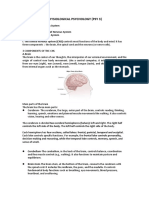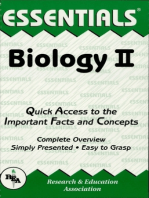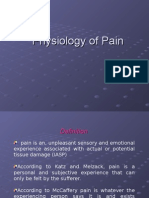Improve Cognitive Functions
Improve Cognitive Functions
Uploaded by
AeFondevillaCopyright:
Available Formats
Improve Cognitive Functions
Improve Cognitive Functions
Uploaded by
AeFondevillaOriginal Description:
Original Title
Copyright
Available Formats
Share this document
Did you find this document useful?
Is this content inappropriate?
Copyright:
Available Formats
Improve Cognitive Functions
Improve Cognitive Functions
Uploaded by
AeFondevillaCopyright:
Available Formats
Parts of the Brain
1. Meninges- protects the brain and spinal cord form mechanical injury; provides blood supply to
the skull and to the hemispheres provides a space for the flow of cerebrospinal fluid.
2. Gyrus- Each of the gyrus corresponds to a specific voluntary movement
3. Sulcus- improve cognitive functions
4. Cerebrum- where things like judgment, decision, perception and imagination appear
5. Cerebellum- controls the movement of the human body
6. Vermis- control of muscle tone and level of force
7. Arbor vitae- brings sensory and motor information to and from the cerebellum
8. Thalamus- involved in sensory perception and regulation of motor functions.
9. Hypothalamus- controls the release of 8 major hormones by the hypophysis, and is involved in
temperature regulation, control of food and water intake, sexual behavior and reproduction,
control of daily cycles in physiological state and behavior, and mediation of emotional responses.
10. Corpus callosum- connects the left and right sides of the brain allowing for communication
between both hemispheres. The corpus callosum transfers motor, sensory, and cognitive
information between the brain hemispheres.
11. Septum pallucidum- a barrier between the brain's lateral ventricles, but is not thought to have
any particular function itself.
12. Pituitary organ- makes some hormones, but also acts as an intermediary between the brain and
other endocrine glands. Our hormones and the pituitary gland accomplish many homeostatic and
specialized functions, like bone growth and uterine contractions.
13. Optic chiasma- where the images of the left and right eye are combined to make one picture
rather than two.
14. Pons - part of the metencephalon in the hindbrain. It is involved in motor control and sensory
analysis. For example, information from the ear first enters the brain in the pons. It has parts that
are important for the level of consciousness and for sleep. Some structures within the pons are
linked to the cerebellum, thus are involved in movement and posture.
15. Medulla oblongata- responsible for maintaining vital body functions, such as breathing and heart
rate
16. A. Superior colliculi- can be functionally divided into superficial and deep layers which subserve
somewhat different functions. For example, the superficial layers receive considerable input from
the retina as well as temporal and occipital visual cortex, and respond to moving stimuli. The
superficial layers also project to vision related cranial nerve nuclei.
B.inferior colliculi (corpora quadrigemina)- concerned with detecting and analyzing auditory
stimuli. It sends fibers to the pons and medulla as well as the superior colliculus, and relays
auditory inpulses to the spinal cord, and the nuclei subserving the neck and facial musculature.
Hence, via the IC, auditory impulses can trigger head and body turning and thus orientation
toward sound sources. In mammals, the IC also acts to relay auditory signals received from the
lateral lemniscus to the medial (auditory) geniculate of the thalamus, and in this regard it serves
not only to analyze and orient toward auditory stimuli, but as a major auditory relay nucleus.
Cows Eye
1. Sclera- serves as the eye's protective outer coat.
2. Cornea- helps to shield the rest of the eye from germs, dust, and other harmful matter. And it
acts as the eye's outermost lens. It functions like a window that controls and focuses the entry
of light into the eye.
3. Aqueous humour- fluid nourishes the cornea and the lens and gives the eye it's shape.
4. Iris- helps regulate the amount of light entering the eye. When there is bright light, the iris
closes the pupil to let in less light. And when there is low light, the iris opens up the pupil to let
in more light.
5. Lens- Focuses light rays onto the retina
6. Vitreous humour- helps the eye hold its shape, with light being transmitted through it to the
retina.
7. Retina- senses light and creates electrical impulses that are sent through the optic nerve to the
brain
8. Fovea- center of the macula which provides the sharp vision
9. Tapetum lucidum- increases the amount of light for night vision
10. Optic nerve- carries visual messages from the retina to the brain
You might also like
- ABA 101 Handouts The Autism HelperDocument13 pagesABA 101 Handouts The Autism HelperPedro Guimarães100% (10)
- Know Thyself The Science of Self-Awareness (Stephen M. Fleming)Document245 pagesKnow Thyself The Science of Self-Awareness (Stephen M. Fleming)Angie FonsecaNo ratings yet
- Chapter 2 Cognitive Psychology NotesDocument8 pagesChapter 2 Cognitive Psychology NotesShekinah Pearl Niog100% (1)
- Eating Disorders 1Document17 pagesEating Disorders 1Heba_Al_Khozae100% (1)
- Malignant Self-Love: Narcissism Revisited (10th Ed. 2015) - EXCERPTS ONLYDocument233 pagesMalignant Self-Love: Narcissism Revisited (10th Ed. 2015) - EXCERPTS ONLYSam Vaknin97% (35)
- Challenging Negative Automatic Thoughts - Examples + Worksheets PDFDocument13 pagesChallenging Negative Automatic Thoughts - Examples + Worksheets PDFanon_714254531100% (1)
- Anaphy SemifinalsDocument5 pagesAnaphy SemifinalsRej CosainNo ratings yet
- Control and Coordination, PPT, Module-1.3Document22 pagesControl and Coordination, PPT, Module-1.3Khushi GuptaNo ratings yet
- Human BrainDocument12 pagesHuman BrainJashwanthNo ratings yet
- N Ervous SystemDocument25 pagesN Ervous SystemKate BañesNo ratings yet
- Functions: A. The Neuron 1.cellbody: Transmit A Neurotransmitter From One Neuron To AnotherDocument4 pagesFunctions: A. The Neuron 1.cellbody: Transmit A Neurotransmitter From One Neuron To AnotherKurt Lubim Alaiza-Anggoto Meltrelez-LibertadNo ratings yet
- CNP Module 2 - Brain and Spinal CordDocument13 pagesCNP Module 2 - Brain and Spinal CordTerrin ManjilaNo ratings yet
- Science 10 3RD Quarter NotesDocument20 pagesScience 10 3RD Quarter Notesstephanie adorioNo ratings yet
- Physiological PsychologyDocument25 pagesPhysiological PsychologyasherdoblinNo ratings yet
- Anatomy of The BrainDocument5 pagesAnatomy of The BrainsheilamaemaglaquiNo ratings yet
- Physiological Foundations of BehaviorDocument2 pagesPhysiological Foundations of BehaviorGeloPascual100% (3)
- OUR BODY Chapter - I (Science Class IV)Document4 pagesOUR BODY Chapter - I (Science Class IV)doultaniskNo ratings yet
- Coordination and ResponseDocument6 pagesCoordination and ResponsecleohambiraNo ratings yet
- c5730d07 Week 3 ss3Document4 pagesc5730d07 Week 3 ss3isabellaamelia54321No ratings yet
- Angliski Teksoj 1Document4 pagesAngliski Teksoj 1Martina JovevskaNo ratings yet
- Ope-101-Human Anatomy-ModuleDocument37 pagesOpe-101-Human Anatomy-ModuleAlbert MartinezNo ratings yet
- Human Growth And DevelopmentDocument74 pagesHuman Growth And Developmentanjanasaju1213No ratings yet
- Physiological Psychology ReviewerDocument13 pagesPhysiological Psychology ReviewerLeopando Rod CyrenzNo ratings yet
- Nervous System Reaction PaperDocument3 pagesNervous System Reaction PaperJohn Ruel Sanchez IINo ratings yet
- Neuro Ppt. Lec. 1Document49 pagesNeuro Ppt. Lec. 1Jay successNo ratings yet
- The Central Nervous SystemDocument7 pagesThe Central Nervous Systemjoeywap29No ratings yet
- Neurologic DisordersDocument51 pagesNeurologic DisordersYamSomandar100% (1)
- Biological Basis of BehaviourDocument6 pagesBiological Basis of BehaviourRichard ManuelNo ratings yet
- Biological Basis of Behaviour-IIDocument20 pagesBiological Basis of Behaviour-IIJaveria Zia100% (1)
- NERVOUS SYSTEM 1&2.Document12 pagesNERVOUS SYSTEM 1&2.omisanmiagnessNo ratings yet
- Control and Coordination PGC Class 10Document7 pagesControl and Coordination PGC Class 10parubansal918No ratings yet
- Anatomy of The Brain: Brain DivisionsDocument3 pagesAnatomy of The Brain: Brain DivisionsUsagi TsukinoNo ratings yet
- Nervous SystemDocument8 pagesNervous SystemBSLMS1D - Depasupil, Laurice Ann A.No ratings yet
- Science Q3 ReviewerDocument11 pagesScience Q3 ReviewerivzenieNo ratings yet
- Parts of Brain CNSDocument5 pagesParts of Brain CNSsafwantatlay2004No ratings yet
- Preparation in Psychology: Bicol University College of Engineering East Campus LegazpiDocument8 pagesPreparation in Psychology: Bicol University College of Engineering East Campus LegazpiKielNo ratings yet
- The Human BrainDocument6 pagesThe Human BraindamanzurNo ratings yet
- Nervous System ReportDocument11 pagesNervous System ReportsharkNo ratings yet
- Chapter 3Document1 pageChapter 3Emilia RuedaNo ratings yet
- Raheem Fatima Assignment 1Document26 pagesRaheem Fatima Assignment 1zarabatooltahir123No ratings yet
- Central Nervous SystemDocument24 pagesCentral Nervous SystemanushkaNo ratings yet
- CLASS 10 CHP 6 CONTROL AND COORDINATION QA 2024-25Document14 pagesCLASS 10 CHP 6 CONTROL AND COORDINATION QA 2024-256842pranjalNo ratings yet
- Nervous System of The FrogDocument38 pagesNervous System of The Frognone57% (7)
- Raheem Fatima AssignmentDocument15 pagesRaheem Fatima Assignmentzarabatooltahir123No ratings yet
- Biological Basis of Nuer o ScienceDocument34 pagesBiological Basis of Nuer o ScienceNawal TariqNo ratings yet
- Neuron StructureDocument68 pagesNeuron StructureVenkathachala BgNo ratings yet
- Ms - Angeline M.SC (N) Previous Year Psychiatric Nursing Choithram College of NursingDocument79 pagesMs - Angeline M.SC (N) Previous Year Psychiatric Nursing Choithram College of NursingPankaj TirkeyNo ratings yet
- Hassan Nawaz - 202321192010Document15 pagesHassan Nawaz - 202321192010hassanNo ratings yet
- Central Nervous System: The BrainDocument12 pagesCentral Nervous System: The BrainTrishNo ratings yet
- Midterm Reviewer Anaphy LectureDocument15 pagesMidterm Reviewer Anaphy LectureCarlito FantilaganNo ratings yet
- Anatomy and Physiology Chapter 19 Neurological SystemDocument38 pagesAnatomy and Physiology Chapter 19 Neurological SystemBrantNo ratings yet
- Parts of The Nervous System and Their FunctionsDocument44 pagesParts of The Nervous System and Their FunctionsJoshua RapisuraNo ratings yet
- Control and CoordinationDocument11 pagesControl and CoordinationJit AggNo ratings yet
- Brain Structures and Their Functions 1 PDFDocument3 pagesBrain Structures and Their Functions 1 PDFAndrea RamirezNo ratings yet
- Chapter 8: Nervous SystemDocument15 pagesChapter 8: Nervous SystemAndrea BoocNo ratings yet
- Nervous SystemDocument46 pagesNervous SystemMac Gab100% (3)
- Nervou S System:: NeuronsDocument16 pagesNervou S System:: NeuronsFizzah100% (4)
- Disorders of The Nervous System2Document20 pagesDisorders of The Nervous System2Ian Rizavi Villamor AntopinaNo ratings yet
- Untitled Document MKDocument6 pagesUntitled Document MKmeharullahshaikhNo ratings yet
- Nervous System Classs 10th IcseDocument8 pagesNervous System Classs 10th IcsehrsanjeevanihireNo ratings yet
- Master Your Mind: Neuroscience Secrets to Unlocking Your PotentialFrom EverandMaster Your Mind: Neuroscience Secrets to Unlocking Your PotentialNo ratings yet
- sin (x) lim = 1 x: arc length = θDocument3 pagessin (x) lim = 1 x: arc length = θAeFondevillaNo ratings yet
- Andersons Guerrillas LibreDocument21 pagesAndersons Guerrillas LibreAeFondevillaNo ratings yet
- Steam Distillation of Cloves READ:Landgrebe 4 Ed .p160-161 (Section 7.6) and p369-371, 5 Ed. P 140-141 (Section 7.6) and P 321-322Document4 pagesSteam Distillation of Cloves READ:Landgrebe 4 Ed .p160-161 (Section 7.6) and p369-371, 5 Ed. P 140-141 (Section 7.6) and P 321-322AeFondevillaNo ratings yet
- Sharp Minds Membership FormDocument3 pagesSharp Minds Membership FormAeFondevillaNo ratings yet
- SSG OfficersDocument11 pagesSSG OfficersAeFondevillaNo ratings yet
- Speech Plan Title: Specific Speech Purpose: I Would Like To Inform The Class About The Man I Love and ToDocument1 pageSpeech Plan Title: Specific Speech Purpose: I Would Like To Inform The Class About The Man I Love and ToAeFondevillaNo ratings yet
- C Sensors: Item Code: 570000447 Part Number:10 LDR 10mmDocument2 pagesC Sensors: Item Code: 570000447 Part Number:10 LDR 10mmAeFondevillaNo ratings yet
- Evaluation A:: by A Math or Science ProfessorDocument2 pagesEvaluation A:: by A Math or Science ProfessorAeFondevillaNo ratings yet
- DiasporaDocument42 pagesDiasporaAeFondevillaNo ratings yet
- Flow Diagram For Solubility TestsDocument1 pageFlow Diagram For Solubility TestsAeFondevillaNo ratings yet
- Pas " and Is "Typically A Short Number Which Serves As An Introduction For The Suite,"Document3 pagesPas " and Is "Typically A Short Number Which Serves As An Introduction For The Suite,"AeFondevillaNo ratings yet
- The Republic. Plato.: Purchase The Entire Coradella Collegiate Bookshelf On CD atDocument299 pagesThe Republic. Plato.: Purchase The Entire Coradella Collegiate Bookshelf On CD atAeFondevillaNo ratings yet
- Reaction To The Visits in National Museum, Casa Manila and St. Agustin ChurchDocument3 pagesReaction To The Visits in National Museum, Casa Manila and St. Agustin ChurchAeFondevillaNo ratings yet
- Factors That Affect Reading Progress IntelligenceDocument3 pagesFactors That Affect Reading Progress IntelligenceSarah Nicole BrionesNo ratings yet
- Chapter 5: Student Wellbeing: Developing The Cambridge Learner AttributesDocument11 pagesChapter 5: Student Wellbeing: Developing The Cambridge Learner Attributesclara dupitasNo ratings yet
- Bipolar NCPDocument4 pagesBipolar NCPcandy19agustin100% (2)
- Lecture 1 - What Is Sports PsychologyDocument6 pagesLecture 1 - What Is Sports PsychologyAirama VaneitenNo ratings yet
- How Children Learn Math The Science of Math Learning in Research and Practice (Nancy Krasa, Karen Tzanetopoulos, Colleen Maas) (Z-Library)Document415 pagesHow Children Learn Math The Science of Math Learning in Research and Practice (Nancy Krasa, Karen Tzanetopoulos, Colleen Maas) (Z-Library)menghenNo ratings yet
- Clinical Neurobiology of AddictionDocument42 pagesClinical Neurobiology of Addictionbeachbulldog100% (1)
- The Design of Everyday ThingsDocument16 pagesThe Design of Everyday ThingsMichelle DimNo ratings yet
- Webquest Sense of Smell and TasteDocument3 pagesWebquest Sense of Smell and Tastekhudson108No ratings yet
- 4th Periodical Test PerDev TOSDocument2 pages4th Periodical Test PerDev TOSJeric Mirandilla100% (2)
- EDU201 QUIZ 1 Solved by Tanveer Online AcademyDocument2 pagesEDU201 QUIZ 1 Solved by Tanveer Online AcademyyasirpioneerNo ratings yet
- Person-Centered Therapy PPT 02Document16 pagesPerson-Centered Therapy PPT 02pendoish100% (3)
- Daftar PustakaDocument6 pagesDaftar PustakaHevi Eka TarsumNo ratings yet
- Đọc 4Document9 pagesĐọc 4Thục Anh Đỗ LêNo ratings yet
- Kinzer, Suhr 2015Document10 pagesKinzer, Suhr 2015Johanna TakácsNo ratings yet
- Formativa 5to Sem First PartialDocument4 pagesFormativa 5to Sem First PartialEmiliano SharifNo ratings yet
- Physiology of PainDocument35 pagesPhysiology of PainJauhar Firdaus50% (2)
- Discrete Trial Training (DTT)Document9 pagesDiscrete Trial Training (DTT)eckhwan100% (1)
- Facilitating Learning 1Document33 pagesFacilitating Learning 1manolito navarro100% (2)
- Chinese Energetics Fear Phobia Exercise ProgramDocument12 pagesChinese Energetics Fear Phobia Exercise ProgramHola k ase100% (4)
- Building & Maintaining RelationshipsDocument10 pagesBuilding & Maintaining RelationshipsGladez Lucaya Galagaran50% (2)
- Dissertation PaperDocument706 pagesDissertation PaperLESLIE MAGLALANGNo ratings yet
- The Psychology of LearningDocument323 pagesThe Psychology of LearningMiguel Iago CavalcantiNo ratings yet
- A Social Cognitive View of SelfDocument2 pagesA Social Cognitive View of SelfANGELINENo ratings yet
- Relational Frame Theory, Acceptance and Commitment Therapy, and A Functional Analytic Definition of MindfulnessDocument22 pagesRelational Frame Theory, Acceptance and Commitment Therapy, and A Functional Analytic Definition of Mindfulnessdor8661No ratings yet
- MCQDocument4 pagesMCQspraveen2007No ratings yet






































































































